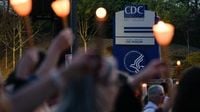In a striking move that underscores the ongoing tensions between state and federal health authorities, the governors of Oregon, Washington, California, and Hawaii have united under the banner of the West Coast Health Alliance to issue their own guidance on COVID-19 booster shots. This alliance, announced on Wednesday, September 17, 2025, marks a significant departure from the Centers for Disease Control and Prevention (CDC) and the Food and Drug Administration (FDA), whose recent recommendations have sparked controversy and concern about politicization at the highest levels of public health leadership.
The immediate catalyst for this regional action was the FDA’s decision last month to approve the latest COVID-19 booster shot, but with a notable limitation: only those over 65 or individuals considered at high risk were recommended to receive it. This approach, critics argue, was not sufficiently grounded in the available scientific evidence and left out broad swaths of the population who might benefit from vaccination. The Advisory Committee on Immunization Practices (ACIP), an independent panel of experts that advises the CDC, is set to meet Friday, September 19, to provide its own recommendations—a meeting expected to be contentious given the current climate.
According to Oregon Public Broadcasting, Dr. Dean Sidelinger, Oregon’s state health officer, explained the rationale behind the alliance’s decision: “This is preserving choice for anyone in Oregon who’s choosing protection from COVID-19 with a safe and effective vaccine for their child or for themselves. That is extremely important, not just here in Portland, but in rural Oregon.” The West Coast Health Alliance’s new guidance states that anyone aged six months and older who wants the vaccine should have access to it, with particular emphasis on those most vulnerable to severe disease.
The alliance’s recommendations are clear: all individuals aged 65 and older should receive the booster, as they have the highest rates of hospitalization. The same goes for children aged six months to 23 months, who have the second-highest hospitalization rates. Dr. Sidelinger noted that “about half the kids who are hospitalized don’t have an underlying condition in that age group, so we can’t parse it out and say ‘just the young kids who have an underlying condition.’” The guidance also strongly encourages vaccination for people with immunocompromising conditions, those with underlying health issues such as diabetes or lung disease, residents of congregate settings (like dorms or skilled nursing facilities), and those working in healthcare or other high-exposure occupations.
But the recommendations don’t stop there. The alliance is also prioritizing the principle of personal choice, allowing healthy adults and children outside the highest-risk categories to opt for vaccination if they wish, especially if they have indirect exposure risks at home or in their community. “Anyone who chooses that protection for themselves, or the people around them, should be able to choose it,” Sidelinger emphasized in his interview.
Developing these recommendations was no small feat. The health officials from the four states convened to review all available data, compiled their findings into a public report, and solicited input from leading professional bodies, including the American Academy of Pediatrics and the American College of Obstetricians and Gynecologists. These groups have long provided independent vaccine guidance, and their expertise was instrumental in shaping the alliance’s policy. “Taking all of that together, looking at the data on who’s getting sick in adults, underlying conditions and their interplay, the health officials amongst the four states — with our immunization experts — compiled these recommendations,” Sidelinger explained to OPB.
The science behind the recommendations is robust. COVID-19 vaccines remain highly effective at preventing severe disease, hospitalization, and long COVID, even as their ability to prevent infection wanes over time. “The vaccine is very efficacious. It works very well at preventing serious disease, that includes hospitalization. It also works well at preventing long COVID for people who get it,” Sidelinger stated. He acknowledged that, for healthy adults who have already been vaccinated and infected, the benefit of another booster is primarily in reducing the risk of short-term illness and long COVID, with the risks of vaccination remaining very low. The rare risk of myocarditis, especially in adolescent and young adult males, is less frequent and less severe than the risk posed by COVID-19 itself.
Access to the vaccine is also central to the alliance’s plan. On the same day the recommendations were released, Oregon’s Board of Pharmacy removed the requirement for a prescription to receive a COVID-19 vaccine, enabling pharmacists to administer the shot directly to anyone eligible. Medicaid and most private insurers regulated by the state continue to cover the vaccine at no cost to patients, though some insurance plans outside state regulation may require verification. “For many Oregonians, coverage hasn’t changed, it’ll be without co-pay, and the state has taken actions to ensure that,” Sidelinger assured.
Underlying these public health decisions is a deeper concern about the politicization of federal agencies. The alliance pointedly cites the leadership of U.S. Health and Human Services Secretary Robert F. Kennedy Jr., a well-known anti-vaccine activist, as a driving factor in their decision to break from federal guidance. “It is painful for me as a public health professional who’s based my career on data and science ... to see that undermined by my federal colleagues,” Sidelinger lamented. Yet he was quick to praise the thousands of CDC and FDA employees who “are continuing to try and follow the science and do the right thing.”
The stakes are especially high for children. According to STAT, as of September 2, 2025, there have been 9,783 cases of COVID-19-related multisystem inflammatory syndrome in children (MIS-C) in the United States, with 80 deaths. MIS-C, which often strikes previously healthy school-age children and can require intensive care due to severe cardiovascular complications like myocarditis, underscores the importance of vaccination for younger populations. Clinical trials and real-world data have consistently shown that COVID-19 vaccines are safe and effective in children, greatly reducing the risk of severe outcomes and hospitalization.
Former CDC Director Rochelle Walensky, writing for STAT, stressed that vaccination in children is a critical component of public health. “Covid-19 vaccination was 94% effective in preventing hospitalization and 98% effective in preventing the need for life support” among adolescents, she reported, citing CDC data. Moreover, more than half of children hospitalized for COVID-19 had no underlying health conditions, dispelling the notion that only those with preexisting vulnerabilities are at risk.
The West Coast Health Alliance’s actions reflect a broader debate about the future of public health in America. By prioritizing both evidence and individual choice, the alliance hopes to restore trust in vaccination and public health recommendations, even as federal agencies grapple with internal and external political pressures. The alliance’s leaders remain adamant that vaccination is essential—not only to protect individuals but to ensure that hospital beds remain available for all emergencies, from car accidents to heart attacks.
As the ACIP prepares to meet and the national conversation around COVID-19 vaccination continues, the West Coast Health Alliance’s bold stance offers a new model for state-led public health leadership—one that places science, transparency, and community needs at the forefront.




